Quantum Sensors
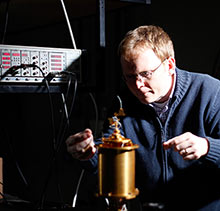
Our group specialises in materials and devices for the most demanding sensing applications, in particular single photon detection deep into the infrared.
Applications for our advanced photon counting technologies include atmospheric remote sensing LiDAR, astronomy, deep space optical communications, fibre temperature sensing, dosimetry for laser cancer treatment, quantum cryptography, quantum optics and the search for dark matter.
Our core expertise is in superconducting materials and devices, but we are actively seeking new avenues for ultrasensitive detection.
We are located in the University of Glasgow's superb new Mazumdar-Shaw Advanced Research Centre (The ARC). We draw upon the world class nanofabrication capability of the James Watt Nanofabrication Centre. We aim to develop joint activities across the science and engineering research base at the University through the Quantum Technologies research theme and the Glasgow Centre for Quantum Technology. We have have been involved in many successful projects within the UK National Quantum Technology Programme, bringing together academic and industry expertise across the UK.
Our work is valued by partners across the UK and globally. Our work is currently supported by the UK Research and Innovation (EPSRC, STFC and Innovate UK), the US National Institutes of Health and the National Research Foundation of South Korea.
Group Members
Academic Staff
- Professor Robert Hadfield (Professor)
Research Fellows/Associates
Lab Manager
Postgraduate Students
- Mahmoud Ahtaiba 2052680a@student.gla.ac.uk
- Bernard Cooper 2605889c@student.gla.ac.uk
- Daniel Kuznesof 2313518k@student.gla.ac.uk
- Nidhi Choudhary 2920174c@student.gla.ac.uk
- Max Patterson 2830858l@student.gla.ac.uk
- Noureldin Amer 2716283a@student.gla.ac.uk
Group addresses
- Professor Hadfield's Office: Room 3116, Mazumdar-Shaw Advanced Research Centre (The ARC), University of Glasgow
- Group Office:Level 3, Mazumdar-Shaw Advanced Research Centre (The ARC), University of Glasgow
- Group Laboratories: 342-346, Level 3, Mazumdar-Shaw Advanced Research Centre (The ARC), University of Glasgow
Visitors
- Dongki Cho, Visting postgraduate researcher from SKKU South Korea (2024-2025)
- Beomgyu Choi, Visiting postgraduate researcher from SKKU South Korea (2024-2025)
- Ciro Bruscino, Visiting postgraduate researcher from University of Naples, Italy (2023-2024)
- Adan Azem, Visiting postgraduate researcher from UBC Canada (2023)
Former Group Members
- Ciaran Lennon (Postgraduate Researcher 2018-2024) - Researcher-in-residence Oxford Instruments Plasma Technology/JWNC University of Glasgow
- Robert Graham (Postgraduate Researcher 2019-2024) - iCURe Explore programme, UK
- Dr Alessandro Casaburi (Marie Curie Fellow/Lecturer/Senior Lecturer University of Glasgow 2013-2023) – Quantware, NL
- Ewan MacKenzie (Postgraduate Researcher 2021-2023) - Electronics Engineering, Leonardo, Edinburgh, UK
- Dr Weikang Zhang (PDRA University of Glasgow 2020-2022) – Postdoctoral Researcher, University of Strathclyde, UK
- Dr Gregor Taylor (PhD University of Glasgow 2021) - Postdoctoral Researcher, NASA Jet Propulsion Laboratory, USA & EPFL Switzerland
- Dr Gavin Orchin (PhD University of Glasgow 2020) - Medical Physicist, NHS Scotland
- Dr Umberto Nasti (PhD University of Glasgow 2020) - Postdoctoral Researcher, Heriot-Watt University, UK
- Dr Konstantinos Tsimvrakidis (PhD University of Glasgow 2020) - Postdoctoral Researcher, FORTH, Crete, Greece
- Dr Jharna Paul (PDRA University of Glasgow 2017-2019) - Kelvin Nanotechnology, UK
- Dr Kleanthis Erotokritou (PhD University of Glasgow 2019) - Postdoctoral Researcher, The Cyprus Institute, Cyprus
- Dr Robert Heath (PhD University of Glasgow 2015) - Postdoctoral Researcher, Centre for Quantum Photonics, University of Bristol, UK
- Dr Archan Banerjee (PhD University of Glasgow 2018) - Postdoctoral Researcher, University of California, Berkeley, USA, Yale University, USA
- Dr Luke Baker (PhD University of Glasgow 2018) - Postdoctoral Researcher, Aalto University, Finland, Microsoft Research UK
- Dr Andrea Pizzone (PhD University of Glasgow 2018) - Postdoctoral Researcher, IMEC, Belgium
- Dr Nathan Gemmell (PhD Heriot-Watt University 2014, Postdoc U Glasgow 2014-17) - Postdoctoral Researcher, Imperial College London, UK
- Dr Robert Kirkwood (PhD University of Glasgow 2017) - Postdoctoral Researcher, National Physical Laboratory, Teddington, UK; KETS, Bristol, UK
- Dr Jian Li (Research Fellow University of Glasgow 2014-16) - Research Professor, National University of Defense Technology (NUDT), Changsha, China
- Dr Chandra Mouli Natarajan (PhD Heriot-Watt University 2011/SU2P Entrepreneurial Fellow Stanford 2012-14/ Research Fellow University of Glasgow 2014-16), Square, USA
- Dr Mike Tanner (Research Fellow Heriot-Watt University & University of Glasgow 2009-2014) - Lecturer, Heriot-Watt University, UK
- Dr Catherine Fitzpatrick (EngD Heriot-Watt University 2013) - Cambridge Consultants, Nu Quantum, UK
Research Projects
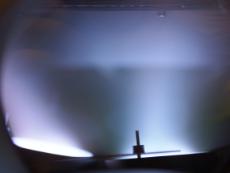
Superconducting detector materials
Contacts: Ciaran Lennon, Nidhi Choudhary, Devendra Kumar Namburi
Main Facility: James Watt Nanofabrication Centre, University of Glasgow
We are exploring a range of superconducting materials for next generation superconducting single-photon detectors. We utilize the state-of-the-art sputtering facilities of the James Watt Nanofabrication Centre at the University of Glasgow enabling high quality deposition of superconducting thin films over large wafer areas. We are working with Oxford Instruments Plasma Technology and TU Eindhoven NL on advanced atomic layer deposition techniques
Dark Matter Detection
Contacts: Devendra Kumar Namburi, Dmitry Morozov, Robert Hadfield
Collaborators: DESY Germany, University of Cardiff UK, NIST USA
We are pleased to be part of the STFC project Quantum enhanced interferometry for new physics led by the University of Cardiff. Our role is to install ultralow noise superconducting detectors in the ALPS II dark matter search experiment at DESY, Hamburg, Germany.
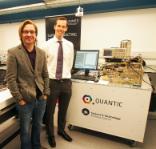 Practical infrared single photon detector systems
Practical infrared single photon detector systems
Contact: Robert Hadfield, Bernard Cooper, Daniel Kuznesof
Collaborations: QUANTIC Quantum Technology Hub, STFC Rutherford Appleton Laboratory, UK, Chase Research Cryogenics
Advanced detectors based on superconducting materials have tremendous potential in applications such as infrared photon counting. The requirement for low temperature operation has been a significant obstacle to the widespread use of such detectors. We are experts in constructing practical systems based on closed-cycle refrigeration. We can mount multiple fibre-coupled detectors inside a single refrigerator. This has enabled us to employ superconducting detectors in a very wide range of applications. We have also delivered full detector systems to scientific partners including the UK National Physical Laboratory, the University of Toronto, Canada, the University of Bristol, UK, the University of Sheffield, UK and ID Quantique SA, Switzerland. Through the QUANTIC quantum technology hub, we have a developed miniaturized cryogenic platform for superconducting detectors in collaboration with STFC Rutherford Appleton Laboratory, UK (pictured: Dr Nathan Gemmell & Dr Matthew Hills). We are now working with Chase Research Cryogenics, Sheffield, UK on next generation miniaturized cooling concepts.
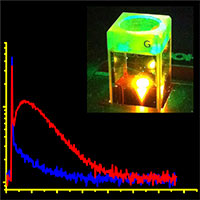 Singlet oxygen luminescence detection
Singlet oxygen luminescence detection
Contact: Robert Hadfield, Vikas
Collaborations: Ontario Cancer Institute, Toronto, Canada; University of Pennsylvania, USA
This is an important medical application of infrared photon counting. Photodynamic therapy is a promising method of cancer treatment, but determining the dose delivered is a serious clinical challenge. By detecting singlet oxygen luminescence at 1270 nm wavelength using a superconducting nanowire, we provide a direct method of dosimetry. Under a major new US National Insitutes of Health project collaboration with UPenn, we are comparing this method to other dosimetry techniques for clinical applications. We are exploring the potential for cellular imaging based on singlet oxygen luminescence.
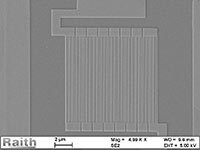 Mid infrared photon counting arrays
Mid infrared photon counting arrays
Contacts: Dmitry Morozov, Vidur Raj, Daniel Kuznesof, Robert Hadfield
Collaborations: QUANTIC Quantum Technology Hub, SPEXS Programme Grant
Superconducting nanowires are a promising technology for infrared photon counting, with low dark counts and excellent timing resolution. Current devices are typically 10 micrometres across, suitable for coupling with single-mode optical fibre. Using state-of-the-art electron beam patterning at the University of Glasgow we aim to develop multipixel nanowire arrays covering much larger areas. Using ultra narrow wires we aim to achieve enhanced mid infrared performance. Through the QUANTIC quantum technology hub we will deploy these next generation devices in advanced imaging and sensing applications.
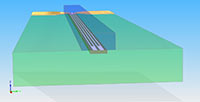
Integrated quantum photonics
Contacts: Robert Hadfield, Mahmoud Ahtaiba, Max Littlewood, Vidur Raj, Dmitry Morozov
Collaborations: UBC Canada, QComm quantum technology hub
The optical photon is an ideal quantum bit or qubit for the transfer and processing of quantum information. Waveguide circuit technology offers an ideal platform for scalable optical quantum information processing. Proof-of-principal demonstrations have already been carried out; the goal now is integrate arrays of detectors together onto complex waveguide circuits.
Selected publications
Practical infrared single-photon detector systems
Cooper, B. E. et al. (2022) 'Compact cryogenics for superconducting photon detectors' Superconductor Science and Technology 35 080501 (doi: 10.1088/1361-6668/ac76e9)
Gemmell, N. R. et al. (2017) 'Miniaturized 4 K platform for infrared superconducting photon counting detectors' Superconductor Science and Technology 30, 11LT01 (doi:10.1088/1361-6668/aa8ac7)
Natarajan, C. M. et al. (2012) 'Superconducting nanowire single-photon detectors: physics and applications' Superconductor Science and Technology, 25 (6). 063001. ISSN 0953-2048 (doi:10.1088/0953-2048/25/6/063001)
Singlet oxygen luminescence detection
Tsimvrakidis, K., Gemmell, N. R., Erotokritou, K., Miki, S., Yabuno, M., Yamashita, T., Terai, H. and Hadfield, R. H. (2019) Enhanced optics for time-resolved singlet oxygen luminescence detection. IEEE Journal of Selected Topics in Quantum Electronics, 25(1), 7000107. (doi: 10.1109/JSTQE.2018.2836962)
Gemmell, N. R., McCarthy, A., Kim, M. M., Veilleux, I., Zhu, T. C., Buller, G. S., Wilson, B. C., and Hadfield, R. H. (2016) A compact fiber-optic probe-based singlet oxygen luminescence detection system. Journal of Biophotonics, (doi:10.1002/jbio.201600078)
Gemmell NR et al (2013) 'Singlet oxygen luminescence detection with a fiber-coupled superconducting nanowire single-photon detector' Optics Express 21 (4) 5005 (Abstract)
Mid infrared photon counting
Taylor GG et al (2021) 'Mid-infrared timing jitter of superconducting nanowire single-photon detectors' Applied Physics Letters 121 214001 (doi:10.1063/5.0128129)
Taylor GG et al (2019) 'Photon counting LIDAR at 2.3 micrometres wavelength with superconducting nanowires' Optics Express 27 (26) 38147 (doi:10.1364/OE.27.038147)
Prabhakar S et al (2020) 'Two-photon quantum interference and entanglement at 2.3 micrometres' Science Advances 6 (13) eaay5195 (doi: 10.1126/sciadv.aay5195)
Superconducting materials for photodetection
Orchin, G.J. et al. (2019) Niobium diselenide superconducting photodetectors. Applied Physics Letters, 114(25), 251103. (doi: 10.1063/1.5097389)
Banerjee, A., Heath, R. M. , Morozov, D. , Hemakumara, D., Nasti, U., Thayne, I. and Hadfield, R. H. (2018) Optical properties of refractory metal based thin films. Optical Materials Express, 8(8), pp. 2072-2088. (doi: 10.1364/OME.8.002072)
Banerjee, A., Baker, L. J., Doye, A., Nord, M., Heath, R. M. , Erotokritou, K., Bosworth, D., Barber, Z. H., MacLaren, I. and Hadfield, R. H. (2017) Characterisation of amorphous molybdenum silicide (MoSi) superconducting thin films and nanowires. Superconductor Science and Technology, 30(8), 084010. (doi: 10.1088/1361-6668/aa76d8)
Integrated quantum photonics
Casaburi, A., Hadfield R. H. (2022) 'Superconducting circuits that mimic the brain' Nature Electronics 5 627
Sibson, P. et al. (2017) Chip-based quantum key distribution.Nature Communications, 8, 13984.(doi:10.1038/ncomms13984)
Li, J. et al. (2016) Nano-optical single-photon response mapping of waveguide integrated molybdenum silicide (MoSi) superconducting nanowires. Optics Express, 24(13), pp. 13931-13938. (doi:10.1364/OE.24.013931
Open positions
PhD Opportunities
We offer a friendly and supportive environment for PhD research.
Current topics for PhD research (for 2025 start)
Nanophotonics for next generation single-photon detection
Advanced photon detectors for space
Dose monitoring for Laser Cancer Treatment
Mid-infrared single-photon remote sensing and spectroscopy
We are happy to accept applications from talented and motivated young researchers who wish to join our team. PhD opportunities are available through several Centres for Doctoral Training which we partner in. Industrial sponsorship can be arranged for candidates wishing to work with our many industrial partners in the UK Quantum Technology sector. Candidates who wish to be considered for PhD research should send a CV and contact details for two referees to Professor Robert Hadfield (Email: robert.hadfield@glasgow.ac.uk)
The usual closing date for scholarship applications is 31st January each year.
More details on PhD opportunities
Postdoctoral Fellowships
The Quantum Sensors group is an ideal location for ambitious early career researchers to develop their careers. We are pleased to support well qualified candidates wishing to apply for research fellowships (for example, UKRI Future Leaders Fellowships, Royal Society University Research Fellowship, Royal Academy of Engineering, Royal Society of Edinburgh Enterprise Fellowships).
Please contact Professor Robert Hadfield (Email: robert.hadfield@glasgow.ac.uk) with a copy of your CV and summary of research interests.
Prizes and Awards
- 2024 German Society for Laser Medicine (DGLM) Young Scientist Poster Prize (Vikas)
- 2023 IOP Superconductivity Group PhD Thesis Prize (Gregor Taylor)
- 2021 STEM for Britain Engineering Gold Medal (Bernard Cooper)
- 2019 Institute of Physics James Joule Medal (Robert Hadfield)
- 2019 Fellowship of the Royal Society of Edinburgh (Robert Hadfield)
- 2018 Royal Society Leverhulme Trust Senior Research Fellowship (Robert Hadfield)
- 2018 Knut and Alice Wallenberg Visiting Professor KTH Stockholm, Sweden (Robert Hadfield)
- 2016 Fellowship of the Optical Society of America (Robert Hadfield)
- 2015 European Research Council Consolidator Grant (Robert Hadfield)
- 2015 Fellowship of the Institution of Engineering and Technology (Robert Hadfield)
- 2013 Brian Pippard Prize of the Institute of Physics Superconductivity Group (Robert Hadfield)
- 2012 J&E Hall Gold Medal of the Institute of Refrigeration (Robert Hadfield)
- 2012 Marie Curie Fellowship (Alessandro Casaburi)
- 2012 Picoquant GmbH Scientific Image Prize (Michael Tanner)
- 2011 SU2P Science Bridges Entrepreneurial Fellowship (Chandra Mouli Natarajan)
- 2010 Fellowship of the Institute of Physics (Robert Hadfield)
- 2007 Royal Society University Research Fellowship (Robert Hadfield)

